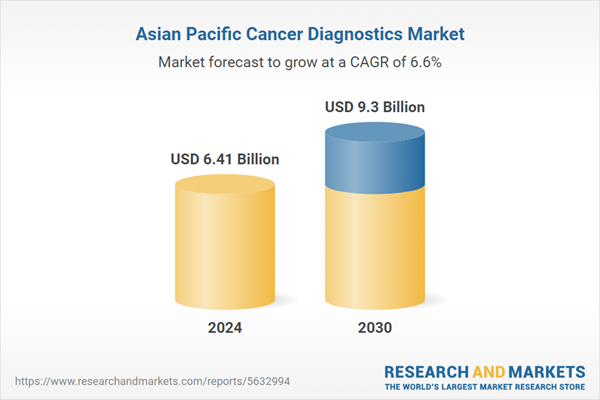Speak directly to the analyst to clarify any post sales queries you may have.
10% Free customizationThis report comes with 10% free customization, enabling you to add data that meets your specific business needs.
These tools are revolutionizing cancer detection by enabling early diagnosis, accurate tumor profiling, and personalized treatment strategies. However, despite this promising outlook, the market contends with challenges including limited access in rural and underserved regions, the high cost of cutting-edge technologies, and regulatory fragmentation. Overcoming these barriers is essential for equitable service delivery and sustainable market expansion.
Key Market Drivers
Growth in Healthcare Industry
Asia’s healthcare sector is anticipated to reach USD 5 trillion by 2030, contributing 40% to global industry growth, and playing a pivotal role in expanding cancer diagnostic capabilities in the region. Government initiatives and private investments have increased healthcare spending and modernized infrastructure, allowing medical institutions to adopt advanced diagnostic technologies. This progress supports broader implementation of cancer screening programs across various countries.Nations such as China, India, Japan, and Australia are witnessing a growing elderly population and a rise in cancer prevalence, fueling the need for accurate and timely diagnostic solutions. In 2020, the cancer incidence rate in Asia stood at 169.1 per 100,000 people, accounting for nearly half of the global cancer burden. The most commonly diagnosed cancers included lung (13.8%), breast (10.8%), and colorectal (10.6%). This elevated burden is pressuring healthcare systems to scale up diagnostic capacity and introduce innovations like in vitro diagnostics, molecular assays, and liquid biopsy techniques into routine medical practice.
Key Market Challenges
High Cost of Advanced Diagnostics
The adoption of high-precision diagnostic technologies in the Asia Pacific cancer diagnostics market is significantly constrained by their cost. Techniques like next-generation sequencing (NGS), liquid biopsies, and molecular imaging, though advanced, are associated with high operational and infrastructure costs, limiting their accessibility - especially in low- and middle-income countries. These technologies often necessitate specialized equipment, well-equipped laboratories, and skilled personnel, resulting in financial strain for many public healthcare institutions. This is particularly true in regions of Southeast Asia, South Asia, and the Pacific, where public resources are limited. Consequently, access to these state-of-the-art diagnostics remains largely confined to urban centers or patients who can afford premium care, thereby restricting the reach of these advanced services across the broader population.Key Market Trends
Expansion of Multi-Omics and Integrated Biomarker Platforms
The cancer diagnostics landscape in Asia Pacific is rapidly evolving with the integration of multi-omics and biomarker-driven platforms. This transformation is powered by the application of artificial intelligence - particularly deep learning and machine learning algorithms - that extract actionable insights from complex datasets. These advancements are enabling the development of more targeted and effective diagnostics and therapies. The limitations of single-marker tests are becoming increasingly evident, leading to a shift toward comprehensive approaches that incorporate genomic, proteomic, metabolomic, and epigenomic data. This multi-dimensional analysis allows for earlier and more accurate cancer detection and supports the personalization of treatment strategies, reinforcing the role of precision medicine in oncology.Key Market Players
- Thermo Fisher Scientific, Inc.
- GE Healthcare
- Abbott Laboratories, Inc.
- Becton, Dickinson, and Company
- F. Hoffmann-La Roche Ltd.
- Boehringer-Ingelheim International GmbH
Report Scope
In this report, the Asia Pacific Cancer Diagnostics Market has been segmented into the following categories, in addition to the industry trends which have also been detailed below:Asia Pacific Cancer Diagnostics Market, By Type:
- Lab Testing
- Genetic Testing
- Imaging Testing
- Biomarkers Testing
- In Vitro Diagnostic Testing
- Biopsy
- Others
Asia Pacific Cancer Diagnostics Market, By Application:
- Lung Cancer
- Breast Cancer
- Colorectal Cancer
- Prostate Cancer
- Kidney Cancer
- Skin Cancer
- Others
Asia Pacific Cancer Diagnostics Market, By Country:
- China
- India
- Japan
- Australia
- South Korea
- Rest of Asia Pacific
Competitive Landscape
Company Profiles: Detailed analysis of the major companies present in the Asia Pacific Cancer Diagnostics Market.Available Customizations:
With the given market data, the publisher offers customizations according to a company's specific needs. The following customization options are available for the report.Company Information
- Detailed analysis and profiling of additional market players (up to five).
This product will be delivered within 1-3 business days.
Table of Contents
Companies Mentioned
- Thermo Fisher Scientific, Inc.
- GE Healthcare
- Abbott Laboratories, Inc.
- Becton, Dickinson, and Company
- F. Hoffmann-La Roche Ltd.
- Boehringer-Ingelheim International GmbH
Table Information
| Report Attribute | Details |
|---|---|
| No. of Pages | 122 |
| Published | June 2025 |
| Forecast Period | 2024 - 2030 |
| Estimated Market Value ( USD | $ 6.41 Billion |
| Forecasted Market Value ( USD | $ 9.3 Billion |
| Compound Annual Growth Rate | 6.6% |
| Regions Covered | Asia Pacific |
| No. of Companies Mentioned | 6 |









